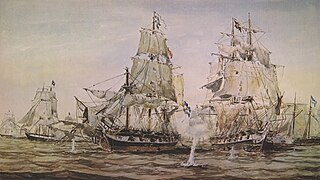
A corvette is a small warship. It is traditionally the smallest class of vessel considered to be a proper warship. The warship class above the corvette is that of the frigate, while the class below was historically that of the sloop-of-war.

Baron Kantarō Suzuki was a Japanese admiral and politician. He was an admiral in the Imperial Japanese Navy, member and final leader of the Imperial Rule Assistance Association and Prime Minister of Japan from 7 April to 17 August 1945.

A patrol boat is a relatively small naval vessel generally designed for coastal defence, border security, or law enforcement. There are many designs for patrol boats, and they generally range in size. They may be operated by a nation's navy, coast guard, police, or customs, and may be intended for marine, estuarine, or river environments.
The Brazilian Navy is the naval service branch of the Brazilian Armed Forces, responsible for conducting naval operations.

The Kamorta-class corvettes or Project 28 are a class of anti-submarine warfare corvettes currently in service with the Indian Navy. Built at Garden Reach Shipbuilders & Engineers (GRSE), Kolkata, they are the first anti-submarine warfare stealth corvettes to be built in India. Project 28 was approved in 2003, with construction of the lead ship, INS Kamorta commencing on 12 August 2005. All of the four corvettes, INS Kamorta, INS Kadmatt, INS Kiltan and INS Kavaratti were commissioned in 2014, 2016, 2017 and 2020 respectively.

The Armed Forces of the Empire of Brazil were the overall unified military forces of the Empire of Brazil. The Brazilian military was first formed by Emperor Dom Pedro I to defend the new nation against the Portuguese in the Brazilian War of Independence. The Army and Armada were commissioned in 1822 with the objective of defeating and expelling the Portuguese troops from Brazilian soil.

Cv Barroso (V-34) is a corvette of the Brazilian Navy, and the lead ship of its sub class. The fifth Brazilian warship to be named after Admiral Francisco Manoel Barroso da Silva, Barroso was launched on 20 December 2002 and commissioned on 19 August 2008.

The Namibian Navy is the maritime warfare branch of the Namibian Defence Force.

The Imperial Brazilian Navy was the navy created at the time of the independence of the Empire of Brazil from the United Kingdom of Portugal, Brazil and the Algarves. It existed between 1822 and 1889 during the vacancy of the constitutional monarchy.
Caboclo means a person having copper-coloured skin in Brazilian Portuguese. Caboclo may also refer to
NS Brendan Simbwaye (P11) is a patrol boat of the Namibian Navy. Constructed and launched in Brazil, it was commissioned into the Namibian Navy in 2009. Its design was based on the Brazilian Navy's Grajaú-class patrol boats. The vessel is used for patrolling Namibia's exclusive economic zone.

NS Lt Gen Dimo Hamaambo (C11) was an Imperial Marinheiro-class corvette of the Namibian Navy. Originally built for the Brazilian Navy as Purus. Purus was part of ten ships of the class ordered by the Brazilian Navy in 1953. Purus was laid down on 20 November 1953, launched on 6 November 1954, and commissioned on 4 July 1955.

The naval Battle of Quilmes took place between a fleet of the Imperial Brazilian Navy, commanded by British admiral James Norton and a fleet of the United Provinces of the Río de la Plata under the command of William Brown. The confrontations began at dawn on July 30, 1826 and lasted for three hours.

The Brazilian ironclad Herval was a Mariz e Barros-class ironclad corvette operated by the Imperial Brazilian Navy from 1866 to 1879. It participated in the battles of the Paraguayan War.

Imperial Marinheiro was a cruiser operated by the Imperial Brazilian Navy between 1884 and 1887. It was the second Brazilian ship to bear this name, a tribute to the country's sailors. It sank in 1887, near the mouth of the Doce River, in Espírito Santo.

The Imperial Marinheiro class is a class of corvettes of the Brazilian Navy.
Marinheiro is a Brazilian surname literally meaning "sailor".
Angostura (S43) is the fourth unit of Riachuelo-class submarine built for the Brazilian Navy by ICN in Itaguaí, and DCNS.
The Brazilian corvette Ipiranga (V17) was a corvette of the Imperial Marinheiro class constructed by the Brazilian Navy in 1953.













